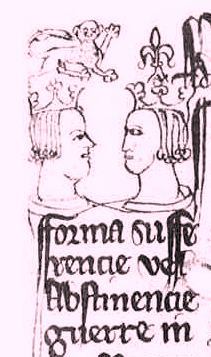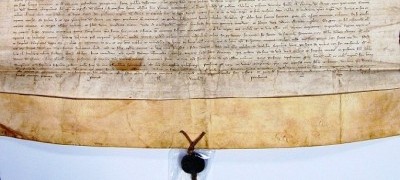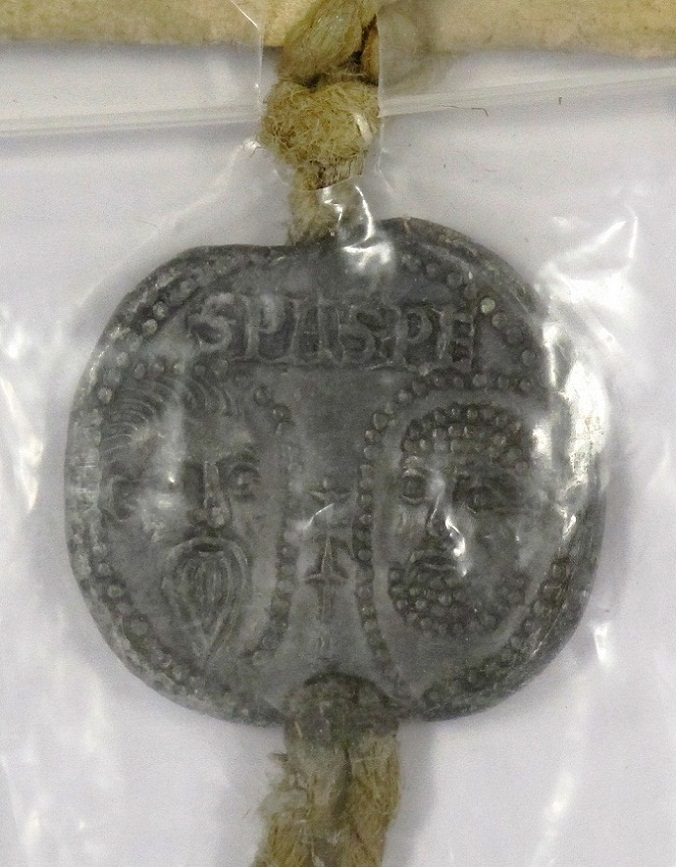
Marginal sketch on a copy of the truce made between England and France at Tournai, 1296-7. Catalogue reference E 368/69 m.54.
On this day 700 years ago Philip IV of France died. He was 46 and rumours circulated that his sudden death was God’s revenge on his destruction of the Knights Templar. The leaders of the Templars had been burnt at the stake the previous March by his command and it was said both he and the Pope were cursed by the Grand Master Jacques de Molay as he died. Here at The National Archives we have several records relating to Philip IV of France, and books in our Library which can help you to understand more about the period.
Philip IV of France was an enigma. He was tall, blonde and handsome (hence the nickname ‘Fair’) but aloof. He was born in Fontainebleau in 1268, the second son of Philip III. His childhood was not the happiest. His mother died when he was three and his stepmother, Marie de Brabant, allegedly preferred her own children to Philip and his brothers. When Louis (Philip’s elder brother) died in 1276 his step-mother was accused of poisoning him but was acquitted. This episode is explored in Elizabeth A. R. Brown’s article The Prince is father of the King: the character and childhood of Philip the Fair of France. When Philip became King there was little contact between them.
Philip the Fair’s character is elusive as smoke. There is limited evidence about his personality but I found a celebrated biography The reign of Philip the Fair by Joseph R. Strayer helped illuminate how his enemies thought of him. One, Bishop Saisset compared him to an owl who simply stared at people but couldn’t speak to them and was controlled by his ministers’ decisions. Yet Philip was also said to be good at getting his own way and could be terrifying to those who crossed him. For example the brutal treatment he meted out to the Templars and to his daughter-in–laws’ lovers, whose adulterous relationships were exposed shortly after the ‘curse’ had been sworn. Their fates could only have been sanctioned by the King.
Edward I as Duke of Aquitaine was a vassal of the French King. A raid by Gascon sailors in 1294 gave Philip the opportunity to go to war with England. Edward I sent his brother to dissuade Philip from war. Philip deceived the English over the terms for peace, one of which was he would send a token army to Aquitaine. In fact Philip sent a large army to the Duchy and would not give Edward safe conduct to go to Gascony and defend his interests. Edward renounced his allegiance to the French King and war broke out between both countries.
No-one is sure why Philip provoked this war with Edward I. Was it a way for the youthful King (still in his twenties) to try to bring his greatest vassal and elder statesman to heel? Edward was about 55 years old at the time. It was rash act for a supposedly cold blooded King.
Eventually a peace treaty of 1303 ended hostilities (E 368/69m.54). It had unforeseen ramifications. Part of the treaty involved Philip’s daughter Isabella marrying Edward’s son and heir, the future Edward II. This led to a period of peace between the two countries but also gave their son Edward III a claim to the French throne, one of the major causes of the Hundred Years’ War.

Request by the Pope to Edward II to arrest the Templars. Catalogue reference SC 7/10/40.
Philip is best remembered for his conflict with Pope Boniface VIII and the Knights Templars. In 1296 Boniface issued a Papal Bull which prohibited taxation of the clergy without the Pope’s approval. He had to retract this under pressure from Philip and Edward I. Gossip began to circulate that Boniface was guilty of heresy, simony and even murder. Philip lapped up these stories. The Pope in 1301 prohibited the French King from taxing the clergy and tried to summon the French clergy to Rome to discuss the French church. Philip responded by calling nationwide assemblies which promised to have the Pope tried for heresy. This culminated in the Pope being arrested in Anagni (Italy) by agents of the King of France. After two days Boniface was freed but the elderly man was shaken by the experience and died a month later.
Another Pope Benedict briefly ruled after Boniface and then Clement V became pontiff in 1305. He was pro-French. He even moved the Papacy to Avignon.

Papal Bull of Pope Clement V. Catalogue reference SC 7/10/40
Philip, because of his wars with England and Flanders, was chronically short of money. This led him to look at the Templars who were a very wealthy order in France and who pledged their allegiance to the Pope above the King. Again alleged heresies began to circulate about the order for example; they worshipped an idol and spat on the crucifix. I found much interesting detail on the alleged heresies the Templars were said to follow in the book, The trial of the Templars. Clement V at first tried to fight these charges but eventually succumbed to pressure from a determined Philip (SC 7/10/40). The Templars in France, unlike the ones in England, were subjected to torture and so often confessed to these heresies. There was shock throughout Europe when all Templars were arrested in France on the same day in 1307. By March 1314 the last of the Templars were burnt at the stake, supposedly cursing the Pope and Philip IV that they would both die within the year.
The Pope died in April 1314. According to the book, The Knights Templars the Pope’s body was placed in a church overnight and the church caught fire and the body turned to ashes. Philip’s last year was troublesome. He found out two of his daughters-in-law were committing adultery. Their lovers were brutally put to death in the market square at Pontoise and the women were thrown into prison. His rigid morality could not cover up the scandal. In November Philip suffered a stroke while out hunting and died soon after at Fontainebleau.
His reign helped to enhance the borders and governmental structures of France but his three sons followed him in quick succession as Kings in their own right and his Capetian line died out in 1328.
If you are interested in reading more about the subject, I’d also recommend these books from our library:
Archives nationales, Grands Documents De L’Histoire de France (Paris, 2007). 944ARC
Alan Forey, The military orders from the twelfth to the early fourteenth centuries(London, 1992). 271.791FOR
Thomas M. Parker, The Knights Templars in England ( Tuscon, 1963). 271.7913PAR

All but the last of your links to books about the Templars DO NOT WORK and come up with a login screen to a library system. Not very helpful.
Dear Tina,
Sorry for the inconvenience. We have now fixed the links. Thanks for bringing it to our attention. Regards Patricia Reynolds
For more on the persecution and burning of the [very wealthy] Templars by Philip IV and the rather grotesque punishments he meted out to his two wayward daughters-in-law and their hapless lovers, see chapter 8 of William Rosen’s “The Third Horseman: Climate Change and the Great Famine of the 14th Century.” It was published in the U.S. by Viking/The Penguin Group, 2014. ISBN 9780-670-02589–3
The Templars ,it should not be forgotten,had great influence in England at this time.Just here in East Kent the village of Temple Ewell ,near Dover,named after their base ,used as a jumping off point to the continent.
The Commandery(in care of English Heritage)which is close by,was believed to have been used by them as a place of refuge by Templars on journeys to and from the near continent
hello.
I would like to go to france and look where the knights templars lived.
is there a ( building/buildings, ) to look at or could you say Exactly where they stood.
I have a ring that has been past down to me . My father died when i was eight years old and just before my mother passed away she gave me things and information that she said is my family history. I am now 63 .
Everything is of knights templars .
thanks monty.
One of the most interesting things to see, is a Tower at Chinon, where many Templars were imprisoned at this time, knowing they were going to die, if not by fire, maybe execution. To see their names they carved on those stone walls is very thought provoking.
Many of the Order ended up in Portugal because the King of Portugal Denis of Portugal was taught by the Templars. The Military Order of Christ (Ordem Militar de Nosso Senhor Jesus Cristo), before 1910 Royal Military Order of Our Lord Jesus Christ ( Real Ordem Militar de Nosso Senhor Jesus Cristo), previously the Order of the Knights of Our Lord Jesus Christ (Ordem dos Cavaleiros de Nosso Senhor Jesus Cristo), is the former Knights Templar order as it was reconstituted in Portugal after the Templars were abolished the 22 of March of 1312 by the Pope. There are several buildings in Portugal where the Templars lived I visited one in the small town of Tomar. Many historians say that Portugal was the last bastion of the Templars in Continental Europe before they jumped to America and that the Order was responsible for passing on their knowledge to the Portuguese reason why they had so much success in the history of navigation.
What about the persistent accusations, for example by novelist and student of the occult Dennis Wheatley, that the French Revolution, 600 years later, was the Templars’ revenge?
Gravestones of Knights Templar can be seen at the Kilmartin Museum in Argyll, Scotland. Here is an article about the Knights Templar in Scotland and their role supporting Robert the Bruce at the battle of Bannockburn: https://commanderysaintmichael.wordpress.com/2018/01/29/the-knight-templar-stones-of-kilmartin-scotland/
There is also information on the Templars in the published Close Rolls, Fine Rolls, and Patent Rolls of Edward II. These show a rough timeline of when the Inquisitors came into England and Ireland. The first record after the suppression in France begins thus, 15 DEC 1307: License to William de la More, Master of the Knights Templars to travel beyond seas, empowering Michael de Baskerville and Peter de Oteryngham, his attorneys, to act for him for one year in divers matters touching that order. It seems unlikely that the Templars in England did not know of the events that had already transpired for their brethren in France.
Philip IV was poisoned. He didn’t die of stroke, although he may have had a stroke after being poisoned. Those who were angry at him for getting rid of the Knights Templar were behind it.
Philip IV’s actions throughout his entire reign put the enemy’s plans for a New World Order behind by 600 years. They have only just recently (in the 20th century) managed to catch up to what they planned to do. They hated Philip IV with a vengeance. It’s a wonder they didn’t manage to poison him much earlier.